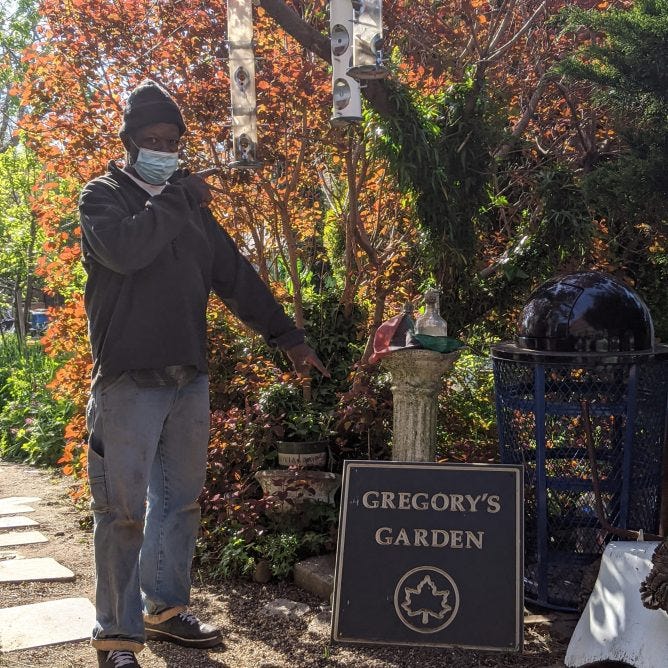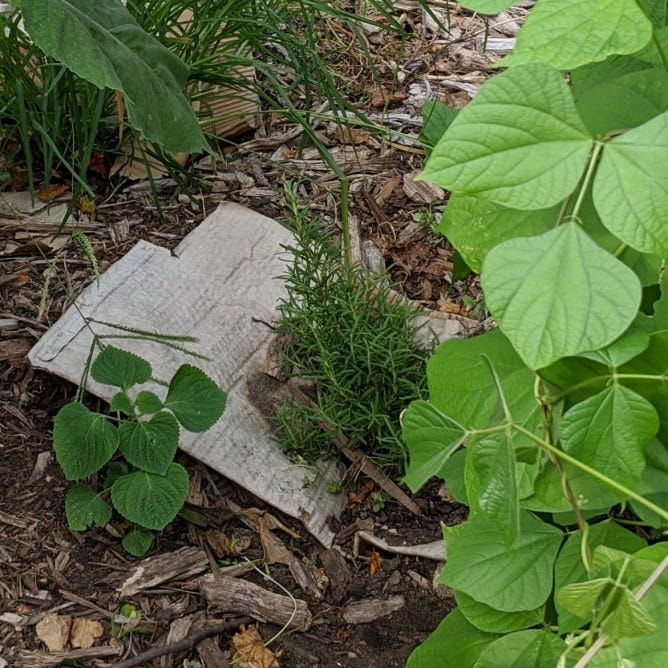The first installment in an on-going series about a feisty woman and her community garden.
Ms. Johana stabs at the earth with a long butcher knife, her hat nodding with each thrust. She’s famous in East New York for her hats, handcrafted from spreads of The New York Times and festooned with flowers and ribbons. She also fashions holiday themed hats such as spiders and skulls for Halloween, flags and sparklers for the Fourth of July, and tiny reindeers and snowmen bounded by strings of colorful battery-powered lights for Christmas. She wears one of her work hats today, constructed from a couple of brown paper bags with the edges of the wide brim furled back and the crown tied with twisted lengths of yellow caution and silver duck tapes. She doesn’t look up if someone has the nerve to shout over a greeting to her and certainly not someone she doesn’t know.
The idea that led me to Ms. Johana began with the pandemic and wondering how the city’s web of community gardens would fare in isolation. Would they allow a small allotment of succor and a much needed food source, especially in underserved neighborhoods such as East New York?
The first garden I pulled up to was run by Gregory Ingham. His fits into the footprint of a typical Brooklyn house lot—20 feet wide by 100 feet long. Neighbors sit for awhile in the cool shade of its grape arbor and maple tree. The elementary school across the street uses his garden as a working classroom. An artist and active member of the Community Board, Greg helps to gather the harvest from the 14 gardens around the area and then distribute boxes filled with fresh produce at food banks.
He wasn’t that pleased when he saw me suddenly wander in.
“I’m thinking as you came walking up, ‘who’s this white woman?’ Either you’re going to serve me a summons for something I didn’t do or you’re one of those real estate people coming around looking to buy land for one of those new apartment buildings going up that’s not for anybody that looks like the people around here.”
What I seem to have going in my favor was the notebook in my hand and the obvious fact of being past the age of someone looking for trouble.
So he led me through the various vegetable beds, around his little fish pond, and over to the children’s teaching boxes full of vegetable sprouts until it was time to close the garden for the night.
“You need to meet Ms. Johana,” he said as I unlocked my car. The garden she tends is one of the biggest and in the midst of being renovated, a story in itself. “She’s the last of her generation. You’ll get a good amount from her.”
He gave me directions and wished me good luck. And here I am now, hacking away with her at an over-grown path.
Ms. Johana is 82 years old and it gives her no pleasure at all being the last of the women she started out gardening with a couple of decades ago. Her best friend in the world, Ms. Adele, passed a few years back. Another died last year and one more in April. Some from diabetes, others plain worn down—or a combination of both. Their gardens lie fallow except for Ms. Adele’s. Someone from the community usurped it not one month after her burial. Ms. Johana believes the woman neither deserves it nor knows a thing about plants, let alone soil.
It should not be pointed out to her that she sort of acquired her garden in the same way. She had just retired from a good computer job at a major television station (she keeps which one it is to herself) and already at loose ends about what to do with her considerable energy. On one of her daily walkabouts she came upon this large corner plot that used to be occupied by a small apartment building before the city tore it down in a fit of urban renewal in the 1990s. The previous gardener died months before and whatever he’d planted was long gone.
She returned the next day with a machete and hacked her way through bamboo and saplings, grass so high it towered over her 4 foot 9 inch frame. The bluestone pavement outside her house was being replaced by cement so she dragged each piece on a blanket the six blocks from her house and made a nice winding path. Someone gave her a pile of silvery mica-flecked rocks to build a rock garden under the pine tree. On the other side she created a children’s play area crowded with toys she trash picked over the years.
The city’s parks department’s GreenThumb program provided the rest of what she needed, mainly dirt, wood chips, and tools. Some years she received help from the young people in their summer internship program. The Brooklyn Botanical Garden donated plants left over from their annual spring sale—a couple of lilac and burning bushes, and plantings for her winding path of Brooklyn native flowers and herbs. Ms. Johana took all their classes to become a certified master composter and pruner and by now she’s probably read every garden book that landed near her.
Her current problem is GreenThumb’s insistence that her garden is not living up to its rules and by-laws. Namely that others be allowed planting beds and have keys to unlock the gate when she isn’t there.
“This garden benefits a lot of people in the community. I was the first to set up a farmers market out there on Nostrand Avenue for the gardeners to sell what they grew. Most of the time, though, I’m here working by myself. I keep the gate partially open so I can hear people come in. My tools are lying around and I don’t want them taking off,” she explains.
In November 2019, GreenThumb workers showed up with a back hoe and just ripped through the lot without letting her know. They took her bluestone path and rocks, and raked up rare varieties of butter and purple hyacinth beans, Peruvian mint, broad leaf thyme favored by Caribbean cooks, Japanese lace, lilacs, mature rosemary and bay leaf shrubs. All gone.
Ms. Johana sits back on her heels. “I got my idiosyncrasies. I know I’m not a girl scout or anything like that. But I expect people to do the right thing. It took me 22 years to make this garden all by myself.”
Covid restrictions mean she can’t count on any young interns in the program to help her. There’s Greg but Ms. Johana is already having doubts about how much time he’ll have between his own garden and his various neighborhood commitments, including organizing Black Lives Matter protests.
“That man has his hands on too many things,” she says. She doesn’t stop whittling at the mug weeds.
“Don't pull nothing unless I tell you to, or you ask me," she warns me.
Ms. Johana points with the tip of her knife to a haphazard arrangement of sticks around what looks like a straggly blade of grass.
“You see those sticks? You come upon those or maybe some pebbles and it’s telling you to stay away.” She rolls way over on her arthritic hip and delicately combs her fingers through the blades. “This is Egyptian garlic. It’ll grow about a foot high and produce a pretty white ball of a flower on top. You use the whole thing—bulb, leaf and the flower you sprinkle over toast or salad or whatever and you have the most delicate just right garlic flavor. Rub it between your fingers then take a lick.”
She gives me a snip. I do what she tells me and emit a small whoop! from the intense flavor. The shocking delight of fresh garlic sways us together in laughter.
“I’m telling you, right? Sooo goood! ” Ms. Johana contemplates the lonely shoot some more, pats a ridge of dirt around it. “I thought I lost a whole crop of them but look how they ran away and hid.”
Except for the arthritis in her knees, Ms. Johana is in good enough shape that she easily bends one way or another doing the weed business, legs curled to the side for ballast. She wears a man’s XXL blue jersey over a long sleeve shirt and sweat pants. Only her strong hands and finely manicured long nails hold on to dirt.
“I have what I call a Mount Vesuvius anger. When I blow, I blow,” she says, which is a good enough warning to be very very careful about weeding. “I promised Ms. Adele I would try to hold back but I can’t believe what they did to my garden. I told them anyone wants to come in and take over a bed, that’s fine with me, except do it the right way. How I tell you to do.”
She lies on her side and reaches toward a particularly thick outcropping near the lilac bush.
“Well, look at that. Rosemary,” she says and hands me a small branch.
Another survivor. It’s a hot May Saturday afternoon and she’s been in the garden for hours. She says she’ll try to make it through this year and do what she can to put the garden back together, though to do it the right way will take another 22 years.
Anyway, the rosemary and Egyptian garlic pleases her, gives her hope.
We go on weeding.
Note: Thank you all for subscribing! I’ve heard that some have received a message indicating your sign up did not completely go though or that the post landed in your promotion instead of primary mail box. Substack suggests you go to this page to fix the problem. Let me know if you run into any more problems and I’ll ask for additional help. In the mean time, thank you again!






